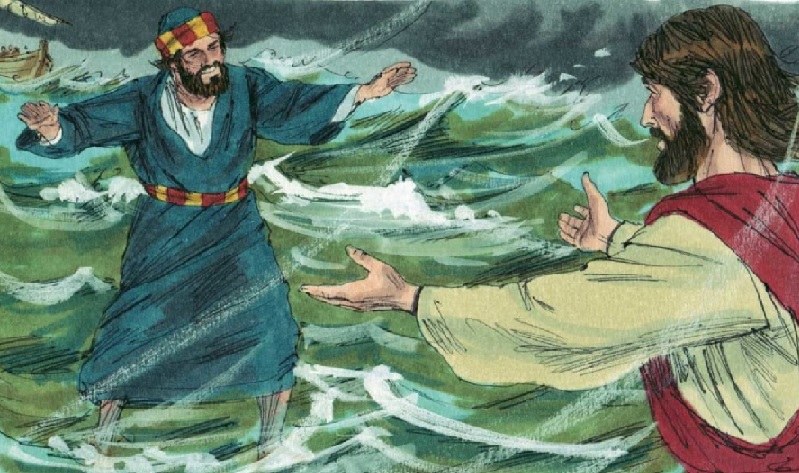“Go therefore and make disciples of all the nations…teaching them to observe all that I commanded you; and lo, I am with you always, even to the end of the age” (Matthew 28:19-20, NASB).
——————–
Contents:
1) Walking on Water (Frank Himmel)
2) The Needle’s Eye (Irvin Himmel)
3) The Body — and Some of Its Members (video sermon, Tom Edwards)
4) News & Notes
——————–

-1-
Walking on Water
Frank Himmel
Modern “miracle workers” focus on two effects: speaking in tongues and healing. Neither accords with the Bible models. Speaking in tongues was speaking in other languages (Acts 2:4-11), not the characteristic gibberish of our day. Bible healings were bonafide cases that even enemies had to acknowledge, not unverifiable headaches, backaches, and the like.
If men today can work miracles, where are the others, the physical effects such as turning water into wine or miraculously multiplying food? And who can walk on water, as the gospel writers say Jesus did? (Matthew 14:22-33; Mark 6:45-52; John 6:16-21).
The Sign
After feeding the 5,000, Jesus not only sent away the multitude, He also made the disciples get into a boat and leave. While He prayed alone on the mountain, they fought their way across a contrary sea. Somewhere between three and six o’clock in the morning, Jesus came to them, walking on the sea. They were frightened, thinking it was a ghost. Jesus reassured them it was He. When He got into the boat with them, the wind stopped. John says immediately the boat was at the land to which they were going.
The Extension
Matthew records a unique aspect of this miracle. Jesus shared the effect by allowing Peter to also walk on water. “Peter said to Him, ‘Lord, if it is You, command me to come to You on the water.’ And He said, ‘Come!’ And Peter got out of the boat, and walked on the water and came toward Jesus. But seeing the wind, he became frightened, and beginning to sink, he cried out, ‘Lord, save me!’ Immediately Jesus stretched out His hand and took hold of him, and said to him, ‘You of little faith, why did you doubt?’” (Matthew 14:28-31).
Extending the miracle in this way had several benefits. It verified to the apostles the reality of what was taking place. It illustrated the Savior’s favorable disposition toward them. And it taught them the valuable lesson that even in the exercise of supernatural gifts, one must act from personal faith if he is to be successful.
The Purpose
Peter’s success when walking by faith is a great illustration. So is his failure when he took his eyes off Jesus and focused on his circumstances. So is his simple, fervent prayer, “Lord, save me.” So is the Lord’s response.
As with all Jesus’ miracles, however, the main purpose was to show who He is. Mark’s analysis is interesting: “they were utterly astonished, for they had not gained any insight from the incident of the loaves, but their heart was hardened” (6:51-52). It was not hard for them to envision how the creator and ruler of the universe could so easily set aside the “laws of nature.” It was just difficult to see Jesus as that one. Yet that is precisely who He is.
What do you see in Jesus? Have you submitted to His rule?
— Via Pathlights, October 17, 2021
——————–

-2-
The Needle’s Eye
Irvin Himmel
A rich young ruler came running to Jesus and, kneeling before the Master, posed the question, “Good Master, what shall I do that I may inherit eternal life?” Jesus called attention to some of the basic commands of the law. The young man answered, “Master, all these have I observed from my youth.” Jesus, knowing that he lacked one important thing, told him to sell whatever he had, give it to the poor, and he would have treasure in heaven, “and come, take up the cross, and follow me.”
The young ruler reacted by a display of sadness. He went away grieved, for he had great possessions. Looking on the disciples, Jesus remarked, “How hardly shall they that have riches enter into the kingdom of God!”
The disciples reacted with astonishment. Jesus explained, “Children, how hard it is for them that trust in riches to enter into the kingdom of God! It is easier for a camel to go through the eye of a needle, than for a rich man to enter the kingdom of God” (Mk. 10:23-25).
A Gate or Sewing Needle?
In my youthful years, I heard some preacher say that in ancient times there was a small gate in the wall around Jerusalem; and this tiny gate was called “the Needle’s Eye.” According to the preacher, the little gate was used when the big, regular-size gates were closed. It was so small, declared the preacher, that a camel could go through it only by getting down on his knees and squeezing through. The lesson then, according to said preacher, is that a rich man can be saved only by squeezing through — getting on his knees, so to speak, by the proper and sacrificial use of his wealth.
That story impressed me, and in ignorance I repeated it. A more objective study of the passage in which Jesus spoke of the needle’s eye led me in time to reject that story about the gate, and to come to the conclusion that the Lord was speaking of an ordinary kind of needle. First, I noticed that Jesus spoke of a rich man in the sense of one who trusts in riches, not merely one who possesses wealth. Read carefully Mark’s account and notice the following:
“. . . they that have riches” (10:23).
“. . . them that trust in riches” (10:24).
“. . . a rich man” (10:25).
Now, is it possible for people who trust in riches to be saved? Not at all! One must put his trust in the Lord to be saved. They that have riches, that is, they who trust in riches, can no more be saved than a camel can go through the eye of a needle. To a Jew the camel was the largest domestic animal, and the eye of the needle the smallest of openings visible to the eye. Such a large animal passing through such a small hole clearly conveyed an impossibility.
The disciples took Jesus’ illustration to have that meaning. They asked, “Who then can be saved?” Obviously, something would have to change before a camel could go through the eye of a sewing needle. Therefore, Jesus said, “With men it is impossible, but not with God: for with God all things are possible” (v. 27).
It is impossible for one who trusts in riches to be saved, whether he has five dollars or five million dollars. But with God all things are possible. Working through the power of the gospel, God can change a man so that he ceases to trust in himself, his riches, his own wisdom, etc., and puts his trust in Jesus Christ.
Also, it is worthy of note that the Greek word “needle” (rhaphis) used in Mark’s account comes from rhapto, meaning “to sew.” Vine says, “The idea of applying ‘the needle’s eye’ to small gates seems to be a modern one; there is no ancient trace of it. The Lord’s object in the statement is to express human impossibility and there is no need to endeavor to soften the difficulty by taking the needle to mean anything more than the ordinary instrument.” The word for “needle” in Luke’s account is belone, which according to Vincent, “is the peculiar word for the surgical needle.” A.T. Robertson says it “means originally the point of a spear and then a surgeon’s needle.”
McGarvey sums the matter up by saying, “The conceit, which originated I know not where, that ‘the eye of a needle’ here means a low and narrow gate through which the camel could not go except on his knees and after his burden had been removed, is not only without historical foundation, but is inconsistent with the context, which contemplates something impossible with men” (comments on Matt. 19:24).
This article is not designed to needle anyone, but to point out that we need to carefully study the language used before eyeing conclusions.
— Via The Beacon, October 3, 2021
——————–
-3-
The Body — and Some of Its Members
Tom Edwards
For the video sermon with the above title, just click on the following link while on the Internet:
https://thomastedwards.com/wordpress/Body_120521.mp4
——————–
-4-
News & Notes
Folks to be praying for:
Tammy Griffey will be having her surgery on her foot this Wednesday (December 8). It will also require her remaining off her feet for 6 weeks, followed by 6 months of having to take it easy. Update: Tammy’s surgery went well, and she is doing fine.
Let us also continue to remember the family and friends of Shirley Davis who passed away November 22.
Kim Rowell (Ashley Law’s mother) was transferred to a Savannah hospital Friday evening, due to an infection and an ulcer in her dialysis graft, which she will be having surgery for December 5. Update: Her surgery went well. She is now healing and will eventually receive a permanent catheter for dialysis.
Danielle Bartlett is back on the list for a donor kidney. In the meanwhile, she has resumed dialysis 3 times a week.
Ron Montero (Bud’s brother) is continuing with his treatments for cancer.
Rick Cuthbertson‘s treatments have been keeping some of his cancer from progressing.
Vivian Foster has an intestinal blockage that has been giving her some trouble.
Congratulations to Danny and Jan Bartlett in the birth of their 8th grandchild! Their daughter Andra and her newborn both did well.
Let us also be remembering the following in prayer: Ronnie Davis, Doyle Rittenhouse, Deborah Medlock, Kayla Williams, Jim Lively, and Rex Hadley.
——————–
The Steps That Lead to Eternal Salvation
1) Hear the gospel — for that is how faith comes (Rom. 10:17; John 20:30-31).
2) Believe in the deity of Jesus Christ, the Son of God (John 8:24; John 3:18).
3) Repent of sins. For every accountable person has sinned (Romans 3:23; Romans 3:10), which causes one to be spiritually dead (Ephesians 2:1) and separated from God (Isaiah 59:1-2; Romans 6:23). Therefore, repentance of sin is necessary (Luke 13:5; Acts 17:30). For whether the sin seems great or small, there will still be the same penalty for either (Matt. 12:36-37; 2 Cor. 5:10) — and even for a lie (Rev. 21:8).
4) Confess faith in Christ (Rom. 10:9-10; Acts 8:36-38).
5) Be baptized in water for the remission of sins (Mark 16:16; Acts 2:38; 22:16; 1 Pet. 3:21). This is the final step that puts one into Christ (Gal. 3:26-27). For from that baptism, one is then raised as a new creature (2 Cor. 5:17), having all sins forgiven and beginning a new life as a Christian (Rom. 6:3-4). For the one being baptized does so “through faith in the working of God” (Col. 2:12). In other words, believing that God will keep His word and forgive after one submits to these necessary steps. And now as a Christian, we then need to…
6) Continue in the faith by living for the Lord; for, if not, salvation can be lost (Matt. 24:13; Heb. 10:36-39; Rev. 2:10; 2 Pet. 2:20-22).
——————–
Tebeau Street
CHURCH OF CHRIST
1402 Tebeau Street, Waycross, GA 31501
Sunday: 9 a.m. Bible Class and 10 a.m. Worship Service. We also have a Song Service at 5 p.m. for every first Sunday of the month.
evangelist/editor: Tom Edwards (912) 281-9917
Tom@ThomasTEdwards.com
https://thomastedwards.com/go/all.htm/ (This is a link to the older version of the Gospel Observer website, but with bulletins going back to March 4, 1990.)